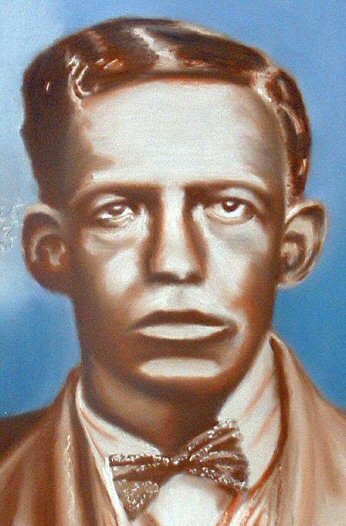
Painting © 2004 Loz
Arkle
Website
© Copyright 2000-2011 Alan White - All
Rights Reserved
Site optimised for Microsoft Internet Explorer
Booger Rooger Blues |
||||||||||||||||||||||||||||||||||||||||||||||||||||||||||||||
|
This article being in the way of an extension of our
knowledge of the term “booger rooger” (“Words Words Words”.
Blues & Rhythm magazine 254. November, 2010).
Lemon’s record in 1926 is the only one listed with ‘Booger Rooger’ included in the title to be found in the entire B.&GR discography’s 4th. edition ( Hey guys, what about a revised 5th. ed.??). But Lemon wasn’t the only Blues singer to make a reference to ‘booger rooger’, even though he doesn’t include the phrase on this recording! Where he does mention it is on Hot Dogs [Paramount 12493] in 1927, as B&R have already noted. It takes the form of a spoken comment when describing a police raid in the barrelhouse, or house party, where he was playing.
That is, he got caught as he couldn’t run fast enough which was no doubt largely due to his blindness. Some four years later Ed Bell and Pillie Bolling recorded an up-tempo side called She’s Got A Nice Line [Columbia 145144]. Bell, as ‘Barefoot Bill, also includes a spoken comment similar to that of Blind Lemon’s in the duo’s 3rd. and last instrumental break on this recording.
Although Bell in one verse refers to his woman who hangs around cabarets raisin’ sand it is almost certainly bound to be the case, that this is because ‘barrelhouse’ does not scan as well as ‘cabaret’. [Footnote 1: As Leola B. Wilson differentiates in her Dirty Spoon Blues of 1932. Where she declares this location “It ain’t no cabaret only a barrelhouse saloon”. (3) This was a remake of Find Me At The Greasy Spoon (If You Miss Me Here) with her husband as ‘Coot Grant & Kid Wilson’ some 7 years earlier in 1925, accompanied by a Fletcher Henderson group]. The 1931 Gene Autry title - Dallas County Jail Blues - (B&R 254, p.25; & B&R 227, p.23) although unheard by me is almost certain to be a cover of an earlier song made in 1930 by vaudeville-blues singer Hattie Burleson. Called High Five Blues [Paramount 13050]-matrix L-615-1.
High Five is on the fifth
floor in Dallas County Jail. (x 2)
I looked at the walls, I
could picture my baby there; The reason there was no bail on High Five is almost certainly because this was where all black prisoners were kept. They would be retained (in the 1920s and ‘30s) to be parcelled out in the corrupt county farm and more horrific convict lease systems. The phrase ‘judge give me six months, but I had to work out nine’ was only too well-known by the African American inmates. Ms. Burleson’s reference to “the prisoners all moaning” definitely indicates a black group; especially singing a blues. It is well-known in the early blues era that as the Lomaxes reported in their famous wandering recording forays, the white convicts did not usually sing but worked in silence. Hattie Burleson had Texas connections and was obviously aware of Lemon’s recording of Hot Dogs. It is readily apparent that ‘booger rooger’ is another name for a barrelhouse or juke joint. But where did the phrase come from? It is tempting to see a connection with ‘boogie’ which in black parlance described a particularly severe case of venereal disease in the early 1900s. But later was usually linked with dancing as well as sex. Black writer Clarence Major lists “Black Boogaloo: a rhythm or dance, the feeling of blackness” (5) Major’s remit seemed to go back only to the 1940s, but New Zealand’s famous lexicographer, Eric Partridge, lists “boogie, boogy. A Negro:1923,” etc. (6). However, there is also this strong sexual link with the barrelhouse or booger rooger. This appears in Lemon’s Booger Rooger Blues where he boasts of his attraction for women. As Yazoo’s team noted: “His popularity with the opposite sex was sufficient to occasion the boast: I got a gal in Oak Cliff, Highland Park, lonesome Long Lincoln, too… Of these sections of Dallas, [Thomas] Shaw said: ‘Oak Cliff that’s where all the colored people hung out,…Highland Park; that’s a richer section…Long Lincoln Land; that’s a kind of hot neighbourhood, where a bunch of high class whores hung around’.” (7) Ultimately, the origins of ‘booger rooger’ are blatantly sexual and include a highly explicit dance which appears in the culture of the Cherokees - one of the famous Five Civilised Tribes of native Americans in the south-eastern states. I have reproduced the text on the ‘Booger Rooger Dance’ in its entirety, by prominent historian/anthropologist Charles Hudson, as it is very probably the only detailed account we are likely to come across at this late point in time. “The bawdy Cherokee booger dance was more a dramatic occasion than a dance. As it was observed in the earlier part of this century, it went as follows. All the people attending a booger dance would assemble at someone’s house. For a while they would amuse themselves with ordinary social dances. Then it would be announced that some strangers were expected. The women and children would begin showing visible excitement and anxiety, a most unusual relaxation of Cherokee rules of demeanor. The air crackling with suspense, the booger gang would appear at the door. They would be four to ten men wearing blankets or sheets wrapped about their bodies and wearing masks representing Northerners, Southerners, Germans, Frenchmen, Chinese, Negroes, and Indians from other tribes. The masks were grotesque. Most of them were carved of wood and dyed various colors using vegetable dyes. Masks of white men often had moustaches and bushy eyebrows made of opossum fur. Another type of white man mask - perhaps that of a mean man - was made of a large wasp or hornet nest that had been hollowed out from inside. Still another white man mask - representing a sex maniac - was made from a gourd. In the center, where the nose should have been, there was a pendulous length of gourd with opossum hair about its base, representing a phallus and pubic hair (fig. 96). 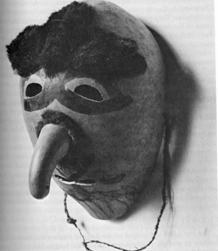 Inscription reads: “Cherokee gourd booger dance mask with phallus nose.” (p.407) When the boogers came into the house, the dance leader would ask them their names. The boogers would pretend to speak languages other than Cherokee; they would whisper, clear their throats, or growl. When they did give their names, they were often obscene. Boogers might be named German, Frenchman, Black, Black Buttocks, Sooty Anus, Rusty Anus, Big Phallus, Her Pudendum has Long Hairs, and so on. In some cases when a booger was asked his name, he replied with the sound of someone breaking wind, at which point everyone would laugh uproariously. Some of the boogers carried beneath cloth wrappings, elaborate phalluses made of gourds. They would suddenly expose them and rush towards the women and girls, who would fall over one another trying to get away. The boogers were hilarious because they were rule-breakers. The Cherokees had many rules of sexual restraint, but the boogers knew no restraint. They would push a man aside and try to get at his wife. Some of the boogers would act as if they were mad, falling to the floor, striking at the spectators. After the dance leader managed to quiet these boisterous ‘strangers’, he would ask them why they had come. “Girls!” they would cry, and the women and girls would scramble out of the way again. Or they would say that they had come to fight, an overt aggressiveness which violated another fundamental Cherokee rule of behaviour. Then the boogers would dance, awkwardly, like white men trying to do an Indian dance. Occasionally, a booger would rush at the women, thrust forward his buttocks, and expose his gourd phallus, leaving the women screaming and giggling. Later the boogers would do a bear or eagle dance and the women, nicely dressed and behaving like upstanding Cherokee women, joined them. The boogers continued their obscene gestures, even imitating the motions of sexual intercourse. But the women were unperturbed. They pretended not to notice. The dance ended when the boogers abruptly and rudely rushed away and out the door, perhaps pausing to try to drag a screaming girl away from her laughing companions. After the boogers went out and laid their costumes and masks aside, they returned inside as ordinary, well-behaved men and joined in the dancing and merriment.” (8) While Hudson reports that the “grotesque” masks worn by “the boogers” represented all races within the US, he makes special mention of those denigrating whites. After describing a couple of these he gives a graphic account of the “white man mask - representing a sex maniac” . (see pic.) Another US author, Page Bryant, generally concurs. The Booger Dance “…takes place in the Great Smoky Mountains and is performed by the Big Cove band of the eastern Cherokees” (9) That is to say the tribes people who did not move to Oklahoma (aka ‘Indian Territory’ until 1907) but remained in the Piedmont area including Georgia and Big Cove, North Carolina. Bryant continues: “The dance consists of four to ten dancers who wear masks that represent people far away. Each dancer takes on an obscene name meant to describe the physical appearance of the whites and to indicate, in a negative way, personal hygiene habits, for example ‘Pale Face who Pees in the Woods’.” (10) Although the example given is mild enough and can hardly be considered obscene - certainly when compared to the list given by Hudson, above! In any event, “The dancers go to the Indians’ houses uninvited, making loud noises and speaking in mock foreign languages. The ghastly masks, painted white, are filled in with bushy mustaches [sic] and eyebrows, whiskers, big noses and bald heads. Sometimes the dancers pretend to be sex-starved whites”. (11) Interestingly, Bryant describes the purpose of the dance as a display of “the anxieties and fears of the tribe; [the Big Cove Cherokee] it is an expression of their insecurities and difficulties in learning to deal with and live in the white man’s world. Cherokees feel that the dance helps them put things into proper perspective and vent their frustrations". (12) The Booger Rooger Dance of Blind Lemon and co. would have identified with the protest role within it and readily adapted it to the African American songbook - particularly the Blues singer. The Nick Nichols’ title Rugger Blues discussed by Howard Rye is most likely a mistaken spelling by a Columbia white recording engineer (fairly common with all the ‘Race’ labels). Chris Smith’s explanation as to how Nichols pronounces ‘rugger’ confirms this. The letter ‘u’ was sometimes voiced by the earlier blues singer, as a double ‘o’ sound. (apologies to linguists!) Most famously, by Arthur ‘Big Boy’ Crudup whose surname would be phonetically printed as ‘Croodup’, the way he sings it on his superb Death Valley Blues [Bluebird B8858] in 1941. Addendum The Texas Link Although Cherokee homelands were originally in Georgia and the Carolinas, in the 1830s they were included in the infamous US government removal policy. The large majority of the tribe were forced westward marked by the horrendous ‘Trail of Tears’ to what was known as Indian Territory - the “Territor’” so often referred to in early blues. Together with the other four members of the Five Civilised Tribes (Choctaw, Chickasaw, Creek, & Seminole) the Cherokee were ‘allocated’ the eastern strip of a much larger area which became the state of Oklahoma in 1907. Its eastern border is adjacent to Arkansas and Missouri, while its south-eastern neighbour is East Texas. Before statehood and out of jurisdiction of the US Federal laws many people - including blacks - were attracted to the lawless Territory. [Footnote 2: See 'Red Man And The Blues' an unpublished dissertation (c. 12,000 words) by Max Haymes. 1990. Lancaster University, Now on earlyblues.com website. Click here]. Some early blues singers (and their precursors) would have found the temptation to milk the ‘rich’ pickings playing for crowds desperate for entertainment irresistible. As well as escaping the oppressive Jim Crow atmosphere in the South Even if for only a short while. But a stubborn much smaller group of the Cherokee remained in the Carolinas. The well-travelled Blind Lemon Jefferson is almost bound to have come across the booger rooger dance culture in his earlier days.
I flyin’ [on a fast train] to
South Carolina. I got to go there this time. (x 2)
Long Distance, Long Distance.
Will you please give me a credit call?
Hey! Long Distance, I can’t
help but moan; It is well reported that in the early 1920s Lemon certainly roamed around the state of Alabama and especially Mobile’s waterfront. Ed Bell, from southern Alabama, may have seen him performing Hot Dogs and used the booger rooger phrase in his duet with Pillie Bolling. Copyright Ó Max Haymes, January 2010. All Rights Reserved __________________________________________________________________________ Notes:
Bibliography:
Discographical details from Blues & Gospel Records 1890-1943 (4th. ed. Rev.) Robert M.W. Dixon. John Godrich. Howard Rye. [Clarendon Press. Oxford] 1997. Additions/corrections by Max Haymes.
Transcriptions by Max Haymes.
Website © Copyright 2000-2011 Alan White. All Rights Reserved. |

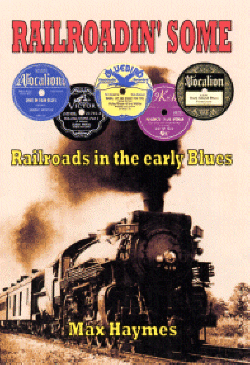
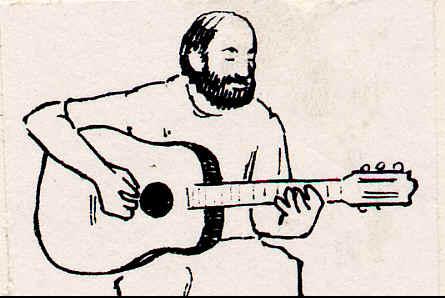





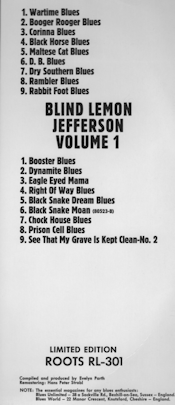 The term came to
light - for Blues fans - via the recording by Blind Lemon Jefferson on the very
first reissue on the old Austrian Roots label (Roots RL 301 L.P. Blind Lemon
Jefferson Vol.1. c.1965). This was Booger Rooger Blues [Paramount
12425] cut c. December, 1926, in Chicago; matrix 3088-2. Of course much later,
in the 21st. century, this title reappeared on CDs - in much improved
sound. One such reissue which is still available in 2010 is the essential 4-CD
set by Blind Lemon Jefferson, on JSP Records (JSP 7706). In passing, I am not
aware of 3088-1 coming to light at the time of writing; if indeed Paramount ever
issued it.
The term came to
light - for Blues fans - via the recording by Blind Lemon Jefferson on the very
first reissue on the old Austrian Roots label (Roots RL 301 L.P. Blind Lemon
Jefferson Vol.1. c.1965). This was Booger Rooger Blues [Paramount
12425] cut c. December, 1926, in Chicago; matrix 3088-2. Of course much later,
in the 21st. century, this title reappeared on CDs - in much improved
sound. One such reissue which is still available in 2010 is the essential 4-CD
set by Blind Lemon Jefferson, on JSP Records (JSP 7706). In passing, I am not
aware of 3088-1 coming to light at the time of writing; if indeed Paramount ever
issued it. 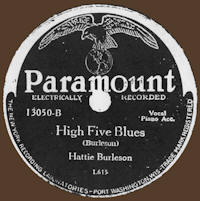 I was at a booger rooger
Saturday night, kickin’ them [legs] high. (x 2)
I was at a booger rooger
Saturday night, kickin’ them [legs] high. (x 2)